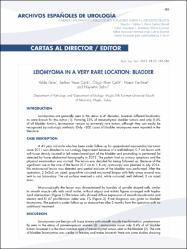| dc.contributor.author | Dere, Yelda | |
| dc.contributor.author | Çelik, Serkan Yaşar | |
| dc.contributor.author | Çelik, Özgür İlhan | |
| dc.contributor.author | Deliktaş, Hasan | |
| dc.contributor.author | Şahin, Hayrettin | |
| dc.date.accessioned | 2020-11-20T15:04:55Z | |
| dc.date.available | 2020-11-20T15:04:55Z | |
| dc.date.issued | 2015 | |
| dc.identifier.issn | 0004-0614 | |
| dc.identifier.issn | 1576-8260 | |
| dc.identifier.uri | https://hdl.handle.net/20.500.12809/2947 | |
| dc.description | WOS: 000361421500001 | en_US |
| dc.description | PubMed ID: 26569011 | en_US |
| dc.description.abstract | Leiomyomas are generally seen in the uterus in 4th decades, however different localizations were known for this tumor (1). Forming 35% of mesenchymal bladder tumors and only 0.4% of all bladder tumors, leiomyomas remain as extremely rare tumors although they can easily be recognized by radiologic methods. Only ~200 cases of bladder leiomyoma were reported in the literature. | en_US |
| dc.item-language.iso | eng | en_US |
| dc.publisher | Iniestares, S.A. | en_US |
| dc.item-rights | info:eu-repo/semantics/closedAccess | en_US |
| dc.title | LEIOMYOMA IN A VERY RARE LOCATION: BLADDER | en_US |
| dc.item-type | editorial | en_US |
| dc.contributor.department | MÜ, Tıp Fakültesi, Cerrahi Tıp Bilimleri Bölümü | en_US |
| dc.contributor.institutionauthor | Dere, Yelda | |
| dc.contributor.institutionauthor | Çelik, Serkan Yaşar | |
| dc.contributor.institutionauthor | Çelik, Özgür İlhan | |
| dc.contributor.institutionauthor | Deliktaş, Hasan | |
| dc.contributor.institutionauthor | Şahin, Hayrettin | |
| dc.identifier.volume | 68 | en_US |
| dc.identifier.issue | 7 | en_US |
| dc.identifier.startpage | 585 | en_US |
| dc.identifier.endpage | 586 | en_US |
| dc.relation.journal | Archivos Espanoles de Urologia | en_US |
| dc.relation.publicationcategory | Diğer | en_US |


















